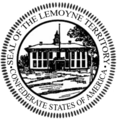Confederate States of America
Confederate States of America | |
|---|---|
| Motto: Deo vindice With God as our protector | |
| Anthem: Dixie | |
 Unfinished map of the Confederate States | |
| Status | Active |
| Capital | Union City (de-facto) |
| Official languages | English |
| Demonym(s) | Confederate |
| Government | Confederal presidential republic |
• President | Cody Dolton Lee |
• Vice President | Jon Kirk |
• Speaker of the House | Kalie Eaves |
| Legislature | Congress |
| Senate | |
| House of Representatives | |
| Independent | |
• Treaty of Union | 21 October 2016 |
• Interim Constitution | 28 October 2016 |
• Permanent Constitution | 21 October 2018 |
| Population | |
• 2019 estimate | 16 |
| GDP (nominal) | estimate |
• Total | $45 USD |
| Currency | Confederate States Dollar United States Dollar |
| Driving side | right |
| Calling code | +1 |
The Confederate States of America (CSA-CS) is a confederacy of nineteen states (six manned governments, where others exist only legally) and four territories. The Confederacy has its de-facto capital situated in the town of Union City, Obion while the nation's de-jure capital is located in Richmond, Virginia.
History
Collapse and Reunification
The initial Confederacy was established in the Montgomery Convention on February 8, 1861, by seven states. Texas joined as its seventh state in March before Lincoln's inauguration, expanded in May–July 1861 (with Virginia, Arkansas, Tennessee, North Carolina), and collapsed in April–May 1865. It was formed by delegations from seven states of the Lower South that had proclaimed their secession from the Union. After the collapse of the nation's military in April 1865, President Jefferson Davis dissolved his cabinet and declared the dissolution of the Confederacy.
One hundred and fifty-one years after its collapse, the Country was reformed under an unstable provisional government in October 2016. The basis upon which the country claimed its reformation was that President Davis had no legal right to declare the dissolution of the nation, though it was dissolved by default. On October 21, 2016: several delegates from independent states around the northwest corner of Tennessee came together in a convention to discuss the probability of unification. The delegates inadvertently declared that they were to be the legal successor to the Confederate Government. The Treaty of Union, at that point, had been signed by delegates from the four separate states. Seven days into the formation of the new country, a constitution was drafted and approved by the delegates, granting themselves the title of legislators in a new "Congressional Council".
A New Government
Not long after the Congress was formed, it had put forth several bills to be enacted. The first of all being, though not particularly a law per se, a bill to denounce the institution of slavery and to officially end it. (Later in a Congressional meeting in 2018, the Congress was discussing a new constitution that was drafted. In this new constitution, several clauses had been made to prevent the re-establishment of slavery. These clauses stated that it was plainly illegal to establish laws reinstating the institution.)
Government and Politics
Federal Government
The federal government of the Confederate States is very similar to that of the United States. In fact, the Constitution was modeled directly from the United States version. The nation’s government, much like the U.S., is comprised of three branches: legislative, executive, judicial.
Legislative
The Legislative assembly of the Confederate States is the C.S. Congress. Comprised of two houses, the Senate and House of Representatives, this assembly determines the laws that govern the Confederacy. The Senate is made up of two senators from each State, for equal representation, while the House of Representatives is based on population. One representative is seated for every 10 people of that state. These politicians submit their own bills to their houses where they discuss them and then vote on them. A bill must have 2/3 majority to pass, if it falters then the bill fails. Yet it can be revised and resubmitted to either house. Senators are chosen every six years by their state legislature, unless a vacancy may come about or an election is called. Representatives are elected by the people for every six years to represent their population. Senators and Representatives are not restricted from holding other offices, meaning that they can serve as heads of departments, governors, and even as President while maintaining multiple other positions.
Executive
The President of the Confederate States is elected every six years by the Electoral College, a group of appointed officials, whose sole purpose is to elect the President based on the wishes of themselves or their state. The President is the Commander in Chief of the Armed Forces, comprising of the Army, Navy, Marine Corps, and local militias, should they be called upon by Congress. The President serves a six-year term, and can be elected as many times as the people see fit. Under the Executive, multiple departments are used for the divisional operation of certain aspects of government. For example defense, foreign affairs, financial administration etc. Specifically these departments are listed as the following:
- Department of War
- Department of State
- Department of the Treasury
- Department of Interior Management
- Department of the Navy
- Post Office Department
Judicial
The Confederate States Supreme Court is the highest court of law within the nation. It is to consist of 9 Judges and a Chief Justice, whom all serve life tenures unless they resign or are removed from office. The Supreme Court’s duty is to carry out cases deemed too important to be handled by inferior courts. In cases of impeachment, a Chief Justice is to stand in a case.
Political divisions
The Confederate States is a constitutional confederation of republics. It consists of eighteen states and one territory. The states and territories are administrative districts in the country to which they delegate their power to the national government. Each state has presidential electors in theory, equal to the number of their representatives and senators in Congress. Territories of the Confederate States, such as Arizona, do not have presidential electors as the territory does not reserve the right to participate in federal elections until it gains statehood.
The Confederate States also observes tribal sovereignty of the American Indian nations by law, but as no native tribes reside within the Confederacy itself, there are no relations between the national government and tribal governments. However, there still exists a Bureau of Indian Affairs under the Department of Interior Management, yet it is not staffed and some have even voiced support for removing the office as it serves no practical purpose as of yet.
Citizenship is granted at birth in all states and to those who seek it from outside the country, based on an application.
Economy
The economic sector of the Confederate States is reliant solely on imports from the United States. There is an effort within the country to kickstart a new program that would favor homegrown products and businesses over foreign imports.
Recognition
Bilateral Recognition
| Flag | Name | Notes |
|---|---|---|
| Bilateral Recognition of The CSA | ||
| Commonwealth of Dracul | ||
| Great Kingdom of Falalia | ||
| Wong Ming Empire | ||
| Commonwealth of Naveria | ||
| Queendom of Nyx | ||
| The Maritime Republic of The Damariscotta | ||
| Unified Royal States of Australis | ||
Unilateral Recognition
| Flag | Name | Notes |
|---|---|---|
| Unilateral Recognition of The CSA | ||
| Sun Republic | CSA is Recognized by the Sun Republic | |
| Republic of Texas | The CSA recognizes Texas | |
| Republic of East Florida. | The CSA recognizes East Flordia | |
| Romanov Empire | The CSA recognizes Romanov | |
| Republic of China | The CSA recognizes Republican China | |
| Manchukuo Temporary Government | The CSA recognizes Manchukuo | |


























